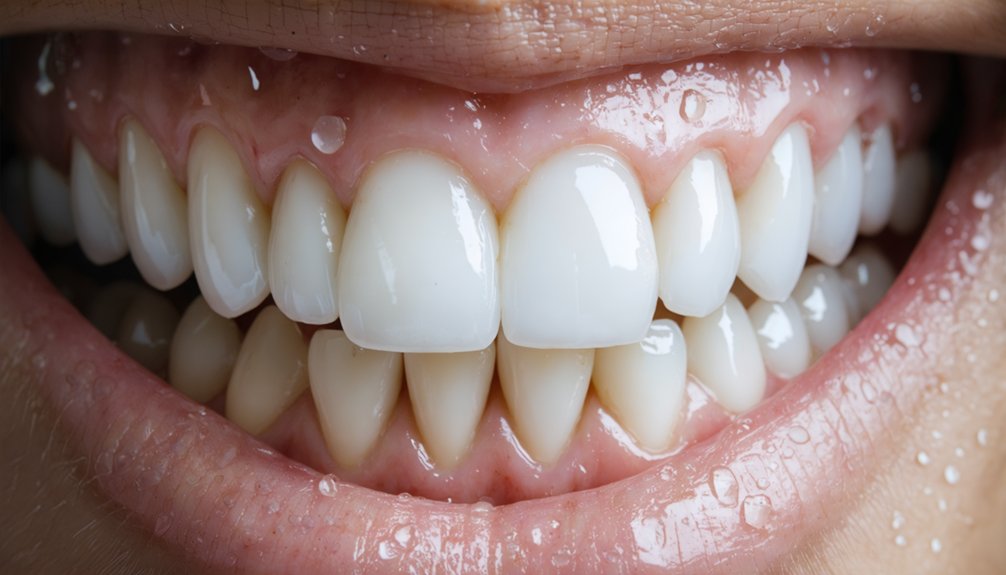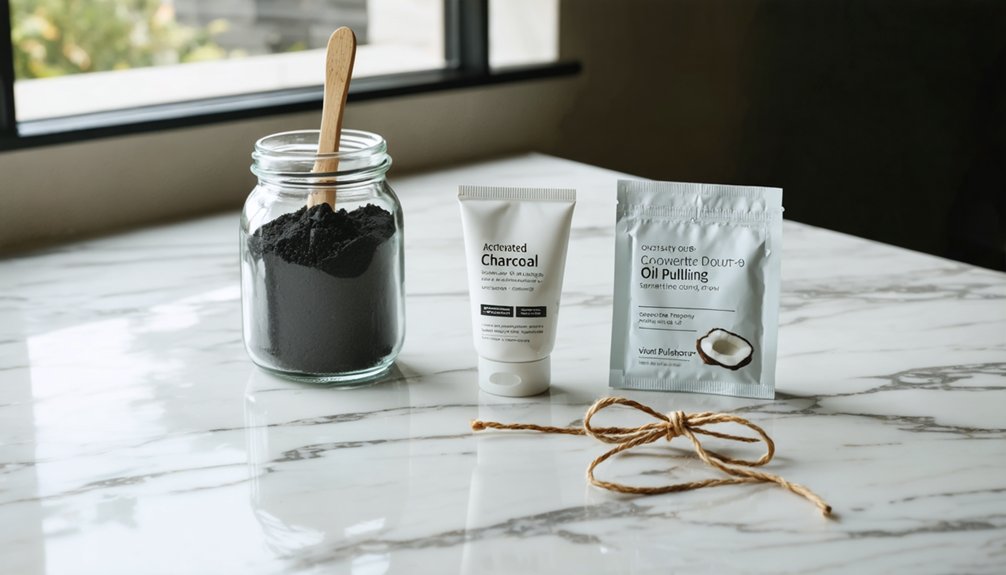Long-lasting teeth whitening works for sensitive teeth because it combines peroxide-based agents with desensitizing compounds like potassium nitrate and fluoride. Your dentist can customize the treatment’s intensity and duration while protecting your enamel and monitoring any sensitivity. Professional whitening uses precise concentrations that break down stains effectively while maintaining comfort. When done properly, you’ll achieve lasting results without compromising your teeth’s health. Understanding the complete process will help you make informed decisions about your treatment options.
Key Takeaways
- Professional whitening treatments use desensitizing agents with fluoride and potassium nitrate before and after sessions to minimize sensitivity.
- Lower peroxide concentrations in long-lasting treatments allow gradual whitening while protecting sensitive teeth from intense exposure.
- Custom-fitted trays ensure even application and minimize gum contact, reducing irritation for those with sensitive teeth.
- Regular breaks between whitening sessions allow teeth to remineralize naturally, preventing prolonged sensitivity while maintaining results.
- Professional supervision enables immediate adjustments to treatment intensity if sensitivity occurs, ensuring both comfort and effective whitening.
Understanding the Science Behind Teeth Whitening
While teeth whitening may seem like a purely cosmetic procedure, the science behind it involves complex chemical interactions between whitening agents and tooth structure.
Your teeth’s enamel acts as a semipermeable membrane, allowing whitening agents like hydrogen peroxide to penetrate and reach stains embedded in deeper layers.
When whitening agents contact your teeth, they break down into reactive oxygen molecules that target chromophores – the compounds responsible for discoloration.
These free radicals break the bonds of stain molecules, transforming them into smaller, colorless compounds. The process changes how light reflects off your teeth, creating a visibly whiter appearance.
Understanding this mechanism helps explain why professional whitening treatments are designed to optimize penetration while protecting your teeth’s natural structure through carefully balanced pH levels and hydration.
For optimal results, a clinical examination must be performed before any whitening treatment to assess tooth discoloration causes and existing restorations.
The pH-balanced, water-based gel formulation helps minimize tooth sensitivity during the whitening process while maintaining effectiveness.
How Peroxide Breaks Down Stains
The chemical power of peroxide lies at the heart of teeth whitening’s effectiveness. When you understand the stain chemistry involved, you’ll see how peroxide systematically breaks down both surface and deep stains through oxidation mechanisms. The structure similar to water makes it highly effective at penetrating tooth enamel.
As peroxide molecules penetrate your tooth’s enamel, they initiate a targeted attack on stain-causing compounds by removing electrons from their structure. This oxidation process fragments larger, colored molecules into smaller, colorless components, particularly targeting organic compounds like porphyrins that cause yellowing. Iron present in these compounds acts as a natural catalyst for peroxide reactions.
The peroxide breaks down into water and oxygen free radicals, which aggressively disrupt the chemical bonds of stain molecules. For ideal results, the peroxide needs sufficient contact time and concentration to diffuse through the enamel and reach deeper stains in the dentin layer.
The Connection Between Whitening and Tooth Sensitivity
Your teeth can become temporarily sensitive during whitening treatments when peroxide agents expose dentinal tubules, allowing temperature changes and other stimuli to trigger nerve responses.
You’ll likely notice this sensitivity most when consuming hot or cold foods and beverages, as the exposed microscopic channels in your teeth transmit these sensations directly to the nerve endings.
While this discomfort is typically short-lived and subsides as your teeth remineralize after treatment, you can minimize sensitivity by using desensitizing products beforehand and following your dentist’s recommended exposure times. The active ingredients in whitening products contain volatile oxygen molecules that break down stains while temporarily affecting tooth structure. Using a toothpaste like Sensodyne before whitening can help reduce discomfort during the process.
Understanding Sensitivity Triggers
Ever wonder why teeth become sensitive during whitening treatments? The primary sensitivity triggers stem from hydrogen peroxide and carbamide peroxide penetrating your enamel.
These whitening agents create microscopic pores and defects, exposing the dentinal tubules that connect to your tooth’s nerves.
Individual responses to whitening vary based on several factors. If you have pre-existing sensitivity, thin enamel, or dental issues like decay or gum disease, you’ll likely experience more intense reactions. Using products with lower peroxide levels can help minimize discomfort during treatment.
Your age, genetics, and oral hygiene habits also influence sensitivity levels. When consuming hot, cold, or sweet items during treatment, you may notice discomfort as fluid moves through the exposed tubules, stimulating nerve endings. Most patients experience sensitivity for a few days, though some individuals may feel discomfort longer.
While these effects are usually temporary, higher peroxide concentrations and longer exposure times increase both the risk and severity of sensitivity.
Managing Whitening Side Effects
While tooth whitening effectively brightens smiles, understanding its side effects helps you manage sensitivity during treatment.
When peroxide-based whitening agents penetrate your enamel, they temporarily expose dentinal tubules and can inflame the tooth’s pulp, causing discomfort. Your sensitivity management strategy should include using desensitizing agents before and after treatment. Saltwater rinses can provide relief for irritated gums after whitening sessions.
You’ll find relief by applying fluoride treatments to remineralize enamel and block exposed tubules.
During whitening, avoid extreme temperatures in foods and beverages, as cold stimuli particularly trigger sensitivity. If you’re prone to tooth sensitivity, opt for lower peroxide concentrations and shorter treatment sessions. Custom-fitted trays from your dentist can help minimize contact with sensitive areas.
Consider taking over-the-counter pain relievers if needed, but remember that most sensitivity peaks within 24 hours and resolves as your enamel naturally remineralizes.
Managing Sensitivity During Treatment
Managing tooth sensitivity during whitening treatments requires a careful balance between achieving desired results and minimizing discomfort.
For effective sensitivity management, you’ll need to adjust your treatment approach strategically. Reduce the frequency and duration of whitening sessions to allow your enamel time to recover between applications. If you’re using at-home treatments, make sure you’re working with custom-fitted trays to prevent uneven exposure and gum irritation.
During professional treatments, your dentist can incorporate desensitizing agents containing fluoride or potassium nitrate to reduce discomfort.
If you experience severe sensitivity, don’t hesitate to pause the treatment. Make treatment adjustments by switching to lower-concentration whitening agents, which can still provide results while minimizing sensitivity.
Always follow manufacturer’s instructions carefully to avoid overexposure to whitening products.
Best Practices for Long-Term Results
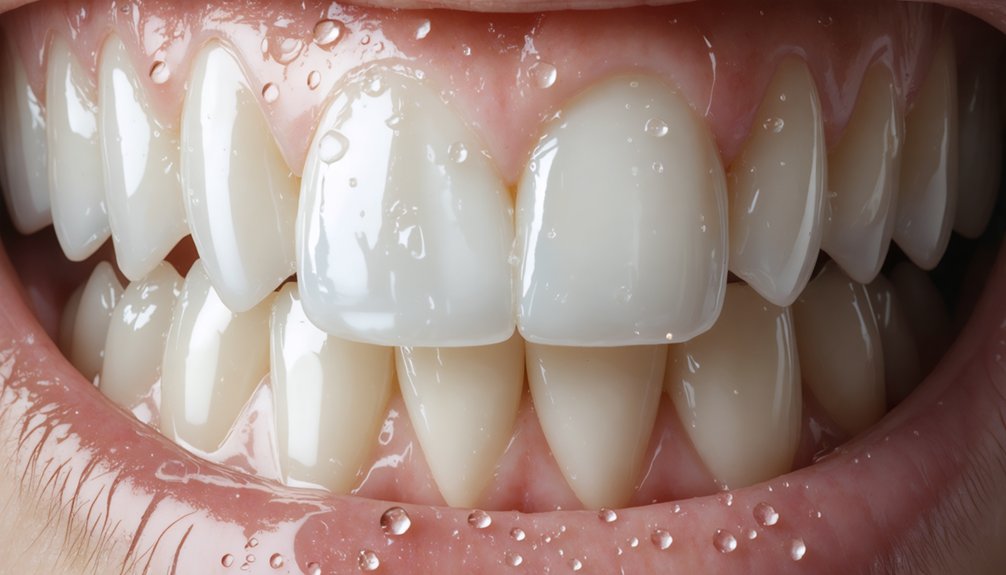
To maintain lasting results from teeth whitening when you have sensitive teeth, following evidence-based practices becomes essential.
Managing whitening frequency and supporting enamel remineralization through professional guidance helps achieve ideal results while minimizing discomfort. Your long-term success depends on implementing protective measures that preserve enamel integrity and reduce sensitivity triggers.
- Use desensitizing agents containing fluoride or potassium nitrate before and after treatments
- Adjust whitening sessions to shorter durations with breaks between applications
- Choose gentle whitening products with low peroxide concentrations in custom trays
- Avoid staining beverages and acidic foods that can compromise enamel strength
- Schedule regular dental check-ups to monitor enamel health and receive professional maintenance
Professional vs. At-Home Whitening Options
When choosing between professional and at-home whitening treatments for sensitive teeth, you’ll find that professional options use higher concentrations of peroxide under strict safety protocols, while at-home kits contain gentler formulations for gradual results.
Your dentist can precisely control the intensity of professional treatments, adjusting exposure times and using protective barriers to minimize sensitivity and gum irritation.
At-home options, though milder, still require careful adherence to instructions since improper use can lead to uneven results or increased tooth sensitivity.
Treatment Intensity Differences
Professional teeth whitening treatments differ markedly from at-home options in their intensity and effectiveness. Your dentist can precisely control treatment intensity while balancing sensitivity concerns, offering considerably faster and more dramatic results compared to over-the-counter products.
- Professional treatments use higher hydrogen peroxide concentrations, achieving up to eight shades of brightening in one session.
- In-office procedures combine concentrated gel with light or laser activation for immediate results.
- Custom-fitted trays guarantee ideal contact and even distribution of whitening agents.
- Professional oversight allows for immediate adjustments if sensitivity occurs.
- Results last longer due to deeper enamel penetration compared to at-home methods.
You’ll find that professional treatments, while more expensive, offer a carefully controlled balance between achieving desired results and managing tooth sensitivity through customized approaches and expert supervision.
Safety Protocol Comparisons
Since safety remains paramount in teeth whitening procedures, understanding the distinct protocols between professional and at-home options can greatly influence your treatment success.
Professional whitening incorporates essential safety measures, including pre-treatment assessments, customized concentrations, and protective barriers for your gums and soft tissues.
During in-office treatments, dentists implement strict monitoring protocols, allowing them to adjust or halt the process if sensitivity occurs. They’ll provide personalized desensitizing agents and carefully control peroxide levels to protect your enamel.
In contrast, at-home kits lack professional oversight and may contain variable concentrations that could harm sensitive teeth. While both options can whiten your teeth, professional treatments offer real-time supervision, custom-fitted trays, and immediate intervention capabilities that notably reduce your risk of adverse effects.
The Role of Enamel Protection
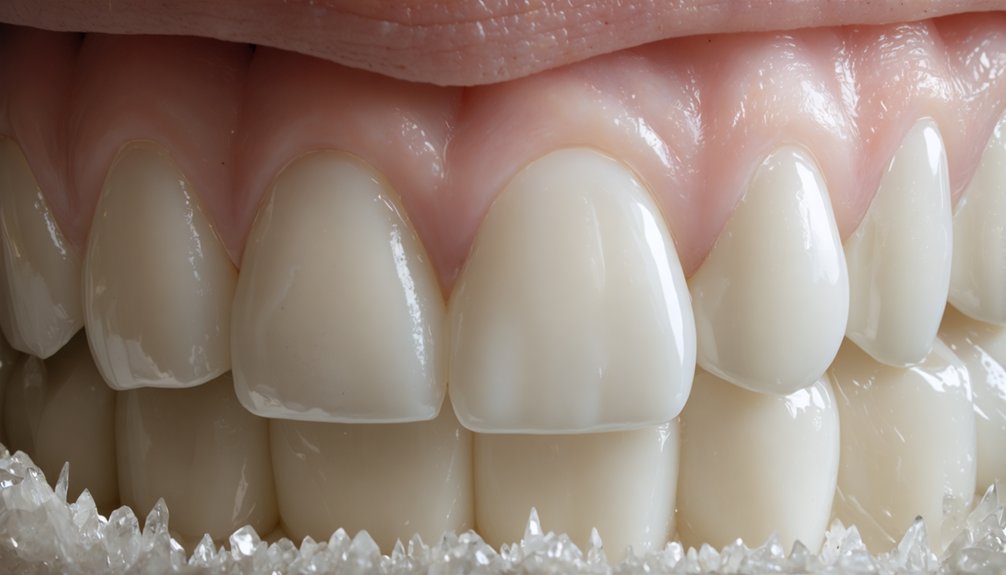
Understanding enamel protection is vital for successful teeth whitening, particularly if you have sensitive teeth. Your enamel’s primary role is to protect against decay and sensitivity while masking the yellowish dentin beneath. Since enamel can’t regenerate once damaged, protective measures during whitening are imperative for long-term oral health.
- Choose pH-balanced whitening products that won’t compromise your enamel’s mineral structure.
- Maintain proper application techniques to prevent uneven exposure and enamel damage.
- Follow post-treatment care with enamel-strengthening products to support remineralization.
- Avoid acidic foods and beverages during and immediately after whitening sessions.
- Consider professional guidance for enamel preservation, especially if you have pre-existing sensitivity.
These protective steps help guarantee effective whitening while maintaining your enamel’s integrity, leading to lasting results with minimal sensitivity.
Customizing Treatment for Sensitive Teeth
Building on the foundation of enamel protection, customized whitening approaches offer targeted solutions for sensitive teeth. Your dentist can create custom trays that precisely fit your teeth, ensuring even gel distribution while minimizing gum exposure.
These personalized trays allow you to use lower-strength whitening agents effectively at home, reducing the risk of sensitivity spikes. Products containing desensitizing agents like potassium nitrate or stannous fluoride help calm nerve irritation during treatment.
You’ll find these ingredients in specially formulated whitening kits, along with separate desensitizing serums for additional comfort. When combined with professional oversight, your dentist can adjust treatment frequency and gel concentration based on your specific needs, making the whitening process both gentle and effective while maintaining your long-term oral comfort.
Maintaining White Teeth Without Discomfort
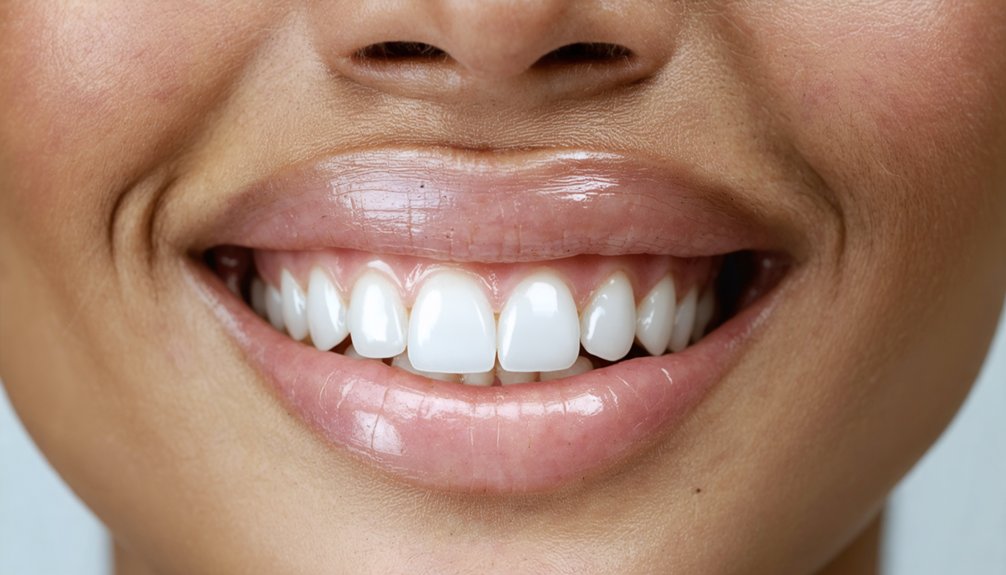
To maintain your newly whitened smile without triggering sensitivity, a careful post-treatment strategy is essential. Effective whitening maintenance strategies combined with sensitivity reduction techniques can help you preserve your results while protecting your teeth.
- Use gentle, peroxide-free whitening agents like PAP for monthly touch-ups to minimize enamel weakening.
- Apply desensitizing toothpaste containing potassium nitrate or stannous fluoride before and after maintenance treatments.
- Follow manufacturer instructions strictly when using at-home products to prevent overexposure.
- Avoid hot, cold, and acidic foods during the first 48 hours after each whitening session.
- Incorporate protective practices like coconut oil swishing to support ongoing oral health while maintaining whiteness.
These evidence-based approaches help you achieve lasting results without compromising comfort, ensuring your smile stays bright and your teeth remain strong.
Frequently Asked Questions
Can Certain Medications Affect the Success of Teeth Whitening Treatments?
Yes, different medication types can greatly affect whitening effectiveness, especially antibiotics like tetracycline, which cause intrinsic staining, and medications causing dry mouth that promote new stain formation.
How Do Pre-Existing Dental Conditions Impact Whitening Treatment Choices?
Like a tailored suit, your dental hygiene history determines your whitening methods. You’ll need customized treatments based on conditions like sensitivity, gum disease, or existing restorations to guarantee safe, effective results.
Does Age Influence How Well Teeth Respond to Whitening Procedures?
Your age considerably impacts whitening effectiveness because younger teeth have thicker enamel and lighter dentin, while older teeth’s thinning enamel and darker dentin reduce potential results from whitening treatments.
Are There Specific Foods That Can Enhance Whitening Results?
You’ll love how certain whitening fruits like strawberries and pineapple naturally boost your results, while dairy products protect against stains. Smart beverage choices and crunchy vegetables enhance professional whitening outcomes.
Why Do Some People Experience Longer-Lasting Results Than Others?
Your genetic factors influence enamel structure and sensitivity, while your lifestyle habits like diet, oral hygiene, and smoking directly impact how long whitening results last in your teeth.
References
- https://harrisburgsmilesdental.com/why-does-teeth-whitening-cause-sensitivity-understanding-the-basics/
- https://www.suttonpda.com/sensitivity-safety-teeth-whitening/
- https://pmc.ncbi.nlm.nih.gov/articles/PMC4058574/
- https://pmc.ncbi.nlm.nih.gov/articles/PMC4229680/
- https://sandlakedental.com/blog/understanding-the-science-behind-teeth-whitening/
- https://www.lakemeadowdental.com/blog/teeth-whitening-guide/
- https://www.ada.org/resources/ada-library/oral-health-topics/whitening
- https://www.clinicalresearchdental.com/blogs/whitening-hygiene/the-science-behind-teeth-whitening
- https://www.zmdental24.com/blog/how-does-teeth-whitening-work-on-sensitive-teeth-a-overview/
- https://pubmed.ncbi.nlm.nih.gov/25969131/
